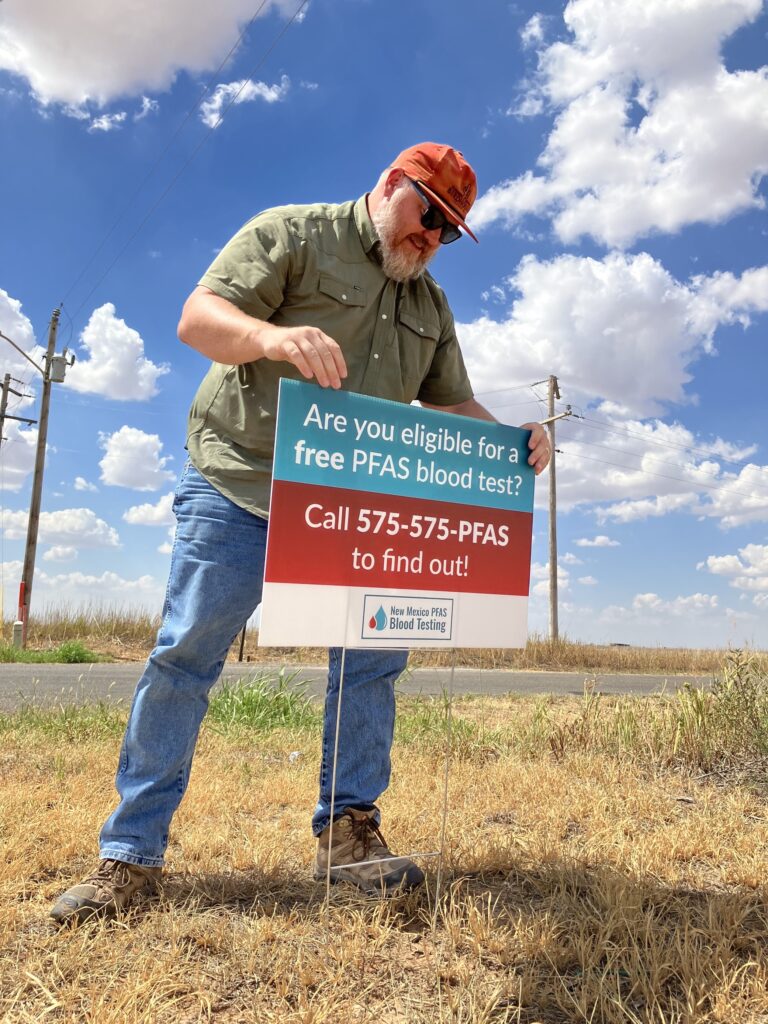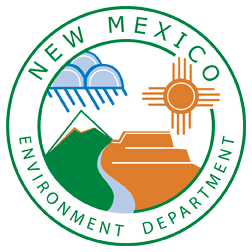PFAS — short for per- and poly-fluoroalkyl substances — are toxic, man-made chemicals that do not break down in the environment. They are often called “forever chemicals” because once they enter our bodies, they stay there forever.

PFAS exposure has been linked in human studies to increased risks of kidney and testicular cancers, changes in liver function, thyroid disease, elevated cholesterol, pregnancy complications (including gestational hypertension and preeclampsia), lower birth weight, and impacts on the immune system such as reduced vaccine antibody response.
Because many PFAS persist and can build up in the body, even small, repeated exposures over time can matter.
What’s the PFAS situation in New Mexico?
In New Mexico, PFAS contamination is most severe near military bases where firefighting foams were used for decades, including at Cannon Air Force Base in Curry County and Holloman Air Force Base in Otero County.
Cannon Air Force Base has created a groundwater plume threatening drinking water supplies, agriculture, and wildlife. In Curry County, more than 3,500 dairy cows had to be euthanized after drinking contaminated water, and blood testing shows that 99.7% of nearby residents tested, have PFAS in their bodies.
At Holloman Lake, which borders Holloman Air Force Base, studies have shown highest concentration of PFAS in plants and animals on the planet. Many of the species tested were migratory birds, which have the potential to take the forever chemicals with them throughout their routes across the American West. The full study can be found here.
How do I protect myself from PFAS in New Mexico?
If you do not live near a known contaminated site:
- Choose PFAS-free products. PFAS are used in many consumer products like cookware, clothing and food packaging. Limiting exposure at home can reduce your risk.
PFAS Central and the Ecology Center provide free guides for PFAS-free purchasing, offering plenty of brands sold in New Mexico: - Check your water. If you are on a private well, consider periodic water testing.
If you do live near a contaminated site
- Still choose PFAS-free products.
- Test your water. If you are on a private well, get your water tested at a certified lab. If you are on public water, check system reports for PFAS results.
- Install a home filtration system. Such systems can reduce PFAS exposure. The Environmental Protection Agency has more information on how to select the right one for your home.
- Have your blood tested for PFAS levels and talk to your healthcare provide. While NMED previously offered free testing near Cannon Air Force Base, the program has been paused for now. However, ask your physician about being tested for PFAS.
The New Mexico Department of Health also has guidance on how to talk to your healthcare provider on how to manage your PFAS exposure and its potential health effects:
What is the State is doing to combat PFAS contamination?
The New Mexico Environment Department (NMED) and the New Mexico Department of Health (NMDOH) are working aggressively to protect residents and hold polluters accountable.
PFAS Blood Testing Program
In Fall 2024, New Mexico offered free PFAS blood testing to adults who lived or worked near Cannon Air Force Base. PFAS are “forever chemicals” found in firefighting foam and many consumer products which can build up in the body over time. The goal was simple: help people understand their personal exposure and give health providers better information to support patients.
The final report shows that PFAS exposure is widespread in the tested community; almost everyone who participated had PFAS detected in their blood. People who lived or worked closest to the known groundwater plume were more likely to have higher levels of specific PFAS directly linked to firefighting-foam use at the base.
Blood testing participants were given a number of resources to help guide them in managing their PFAS exposure forward. Below are NMED’s informational documents for blood testing participants:
- Department of Health fact sheet on how to manage your PFAS exposure
- PFAS Blood Testing Postcard
- Blood Testing Results Department of Health Letter
NMED hosted a public meeting on Thursday, October 23, 2025 for New Mexicans interested in learning more about the results of the PFAS blood testing project:
PFAS Legislation
In the 2025 Legislative Session, New Mexico lawmakers passed and Gov. Michelle Lujan Grisham signed two key bills that will help New Mexico tackle PFAS contamination for generations to come.

House Bill 212, or the PFAS Protection Act, phases out consumer products with intentionally-added PFAS, making sure forever chemicals don’t find their way into New Mexicans’ homes.
Starting January 1, 2027, products such as cookware, food packaging, dental floss, juvenile products, and firefighting foam are banned. On January 1, 2028, it expands to include carpets, cleaning items, cosmetics, fabrics, feminine hygiene products, textiles, ski wax, upholstered furniture, By January 1, 2032, virtually all non‑exempt products containing intentionally added PFAS are prohibited unless deemed a “currently unavoidable use” by the Environmental Improvement Board.
Manufacturers must also begin reporting detailed information about PFAS content in their products by 2027. The legislation includes important exemptions and enforcement provisions — such medical devices and electronic — where PFAS is essential and does not pose serious harm to those using the products.
House Bill 140 amends the state’s Hazardous Waste Act by explicitly classifying discarded firefighting foams containing PFAS—commonly known as aqueous film-forming foams (AFFF)—as hazardous waste, even if they are not federally listed. This empowers the New Mexico Environment Department (NMED) to enforce cleanup and regulatory measures for these persistent “forever chemicals,” shifting the financial burden from taxpayers to polluters. Importantly, the law authorizes the Environmental Improvement Board (EIB) to adopt targeted rules governing disposal and destruction of PFAS-laden foam and ensures that New Mexico’s authority stands even if federal designations evolve.
Legal Actions Against the Department of Defense
The New Mexico Environment Department and Attorney General’s Office first sued the U.S. Department of Defense in 2019, after PFAS from firefighting foam contaminated groundwater near Cannon and Holloman Air Force Bases. The state’s lawsuit seeks to compel the military to halt non-emergency use of PFAS foam, install water treatment and new drinking water lines for impacted residents, implement stormwater controls to prevent further spread, and compensate property owners harmed by the pollution.
More recently, the case has advanced under CERCLA — better known as the Federal Superfund law —where a federal judge has allowed New Mexico’s claims to proceed as a potential bellwether for PFAS litigation nationwide. If successful, the case could force the federal government to fund restoration of the Ogallala Aquifer, cover natural resource damages, and set a precedent for holding the Department of Defense accountable for PFAS contamination across the country.
For more information on recent developments in our case:
- New Mexico seeks costs and damages for PFAS contamination from the U.S. Department of Defense under new U.S. Environmental Protection Agency rule (July 8, 2024)
- New Mexico PFAS claim filed as federal bellwether case (June 27, 2025)
- Air Force denies state inspectors access to test for toxic PFAS (July 24, 2025)


